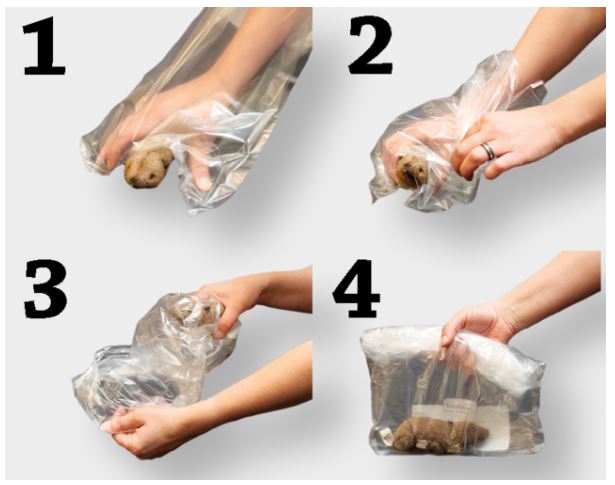Show me your mouse, cat!
Your cat - our researcher
Attention cat owners in Vorarlberg! Under the motto "Show me your mouse, cat!", we are collecting dead mice and other small mammals that your cat brings to your home. From June to November 2024, you can hand in these "gifts" from your cat to us or other collection points in Vorarlberg. The aim of this campaign is to obtain as much data as possible on our native small mammals for the compilation of the Vorarlberg Red List of Small Mammals.
A project as part of the Vorarlberg Red List of Small Mammals
HOW DO I COLLECT A DEAD MOUSE?
Because dead animals can carry pathogens or parasites, the following principle applies: Do not touch a dead animal with your fingers!
Therefore, please proceed as follows:

- Take a plastic bag (e.g. freezer bag) and put your hand in it.
- Grasp the dead mouse with your hand in the plastic bag.
- While holding the mouse with one hand, run your other hand along the edges of the bag over the mouse in your hand.
- Use a pencil to write down the following information about the find on a piece of paper: your name, address, telephone number, e-mail address, date or use the form for reporting (in German) a find. Only fully completed forms result in a scientific data record and can/may be recorded.
- Place the slip of paper in the plastic bag with the mouse.
- Seal the plastic bag tightly and in a space-saving manner (no air in the bag if possible)
- Place the plastic bag in the freezer.
- Take the plastic bag to inatura or one of the collection points at the next opportunity. Please do not allow it to thaw (cool bag/box with cool packs).
If you follow this simple method, you are on the safe side.
PLEASE DO NOT SEND THE DEAD ANIMALS BY POST! THE ANIMALS ARE THEN NOT SUFFICIENTLY COOLED AND DECOMPOSE VERY QUICKLY. PLEASE ONLY SEND ANIMALS WITH FUR (NO BIRDS, REPTILES ETC.)!
Small animals - little knowledge!
There are 29 species of small mammals in Vorarlberg. These include representatives of the dormice, birch mice, true mice, shrews, voles, hedgehogs and moles.
We do not know much about the distribution of small mammal species in Vorarlberg. The available data is poor. But it is precisely this data that we need in order to compile the Vorarlberg Red List of Small Mammals. And that's not so easy - because many of the small animals live very hidden lives and are difficult to find. And this is where your cat comes into play. Its hunting instinct makes it a predator - and therefore a co-researcher for us!
The cat in the service of science
Around 24,000 cats live in Vorarlberg (Statistics Austria 2019/2020).
A cat brings home 1/10 of its prey. However, these "gifts" are not usually met with joy by humans and so the small mammals are disposed of as quickly and inconspicuously as possible.
Unfortunately, it has to be said. Because these prey animals provide valuable information. As dead animals, they can be clearly identified to species. Information on sex, body mass and reproduction can also be obtained from the respective species.
You can find information about our small mammals in Vorarlberg at www.laendlemaus.at (in German).
What is close to our hearts!
So that we are not misunderstood - we are expressly not encouraging you to "send your cat hunting" more often (if that is even possible)! But we do think that if mice and other small mammals are already dying, then their deaths should still have a benefit for scientific research.
Free-roaming cats prey on small mammals, amphibians, reptiles and birds. You can find out how you as a cat owner can enjoy your cat and protect birdlife at the same time at www.birdlife.at.
What data is required?
Your name, address, telephone number, e-mail address, date found.
Please use the report form (in German) and fill it out in pencil.
Only with this information can your dead small mammal be used scientifically!
When can dead small mammals be handed in?
From June to November 2024, dead small mammals can be handed in at inatura and at the drop-off points.
Where are the drop-off points? You can find the list of drop-off points on the project website.
Further information on the "Show me your mouse, cat!" project can be found on the project website.
The project is being realised by the nature museum inatura Erlebnis Naturschau Dornbirn together with apodemus OG - Privates Institut für Wildtierbiologie.
Project duration: June - November 2024
Project management:
Dr. Christine Resch, Dr. Stefan Resch, apodemus OG - Privates Institut für Wildtierbiologie www.apodemus.at
Project organisation:
Dipl.–Biol. Anette Herburger, Teamleitung Forschung der inatura Erlebnis Naturschau GmbH

This project fulfils version 1.1 of the quality criteria for citizen science projects on Österreich forscht.
- animals

